Rubber is an elastic, versatile material widely used in a range of industries for its unique properties such as flexibility, durability, and resistance to water, electricity, and abrasion. It is made from natural and synthetic sources such as latex from rubber trees, styrene-butadiene, and neoprene. Rubber’s elasticity derives from its polymer chains which can stretch without breaking. It is an essential product that is used in vehicle tires, seals, hoses, and footwear. It can insulate against heat and water. In this article, we find out what the best glue for rubber is.
Criteria for Selection
Before we can select the best adhesive, we must define the criteria by which to compare each product. Below you’ll find this criterion:
-
Adhesion Compatibility
The foremost criterion for selecting an adhesive is its ability to bond effectively with rubber. Natural rubber can bond to a wide range of adhesives while synthetic rubbers like silicone, nitrile, or EPDM may require specialized glues.
-
Strength and Durability
Because rubber is often used in load-bearing applications where there is stress and stretching, the adhesive needs sufficient bonding strength to ensure durability and flexibility. Adhesives with a high tensile strength can withstand this pressure.
-
Flexibility and Elasticity
Rubber is an elastic material, and the adhesive must also remain flexible after curing to accommodate the rubber’s movement. Rigid adhesives will crack or fail when bonded to material that bends. Cyanoacrylate, epoxy, and silicone adhesives may perform better in applications requiring flexibility.
-
Curing Time
The curing time affects the outcome of the adhesive application. For example, fast-curing glues provide time efficiency, but they make it difficult to make readjustments shortly after application. Likewise, slower-curing options are more suitable for larger bonding areas and projects requiring precise alignment.
-
Temperature Resistance
Rubber has to withstand temperature fluctuations, and it is important that the adhesive also accommodates this predicament. Silicone and some epoxy formulations are adept at withstanding temperature exposure.
-
Chemical Resistance
If the glued rubber is exposed to chemicals such as oils, solvents, or fuels, the adhesive must resist chemical degradation. Nitrile rubber adhesives or specialty epoxies are specifically designed for chemical resistance. Always verify the label before selecting the adhesive.
-
Waterproofing and Environmental Resistance
For outdoor or marine applications, waterproofing is a key requirement. Rubber adhesives should resist UV light, ozone gases, and humidity to ensure long-term durability. Adhesives that are capable of achieving these standards include polyurethane and silicone adhesives which are known for their water resistance and ability to withstand chemical exposure.
-
Ease of Application
Depending on your skillset, ease of application and handling may be a key consideration in your selection of an adhesive. Epoxies generally come in a resin and hardener and require mixing prior to use. Select an adhesive you can use effectively and with ease. Also, rubber surfaces may require preparation before applying an adhesive such as surface roughening and applying a primer.
-
Toxicity and Safety
You need to ensure that the adhesive is non-toxic or compliant with safety standards especially when dealing with food-grade rubber. For adhesives that emit harmful fumes, wear protective gear or ensure there is adequate ventilation.
-
Cost Effectiveness
Depending on the amount of adhesive you require, you may need to purchase several packages worth of supply at once. You should select an adhesive that aligns with your budget.
5 Best Adhesives for Rubber and Recommended Primers
Here we will recommend the best adhesives for gluing rubber. Some adhesives require a primer so if applicable we will recommend that too.
Loctite Super Glue Gel Control
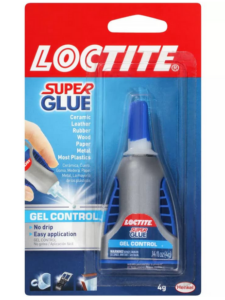
This is a cyanoacrylate glue suitable for small repairs, quick fixes, and general-purpose bonding of rubber to rubber or other dissimilar materials. It has a quick setting time, and the gel formula prevents drip, making it suitable for use on vertical surfaces. It also offers strong adhesion and good durability for light-duty applications. However, it doesn’t offer the degree of flexibility for high-stress applications, as cyanoacrylates are rigid after curing.
The recommended primer for this adhesive is the 3M Scotch-Weld Instant Adhesive Primer which increases surface energy allowing the glue to bond with the substrate more effectively.
3M 847 Nitrile High-Performance Rubber and Gasket Adhesive
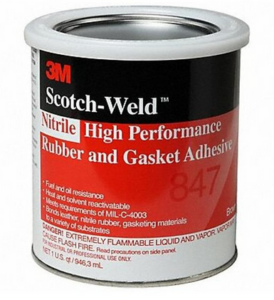
This is a solvent-based contact adhesive suitable for bonding nitrile rubber, natural rubber, and other synthetic rubbers in industrial or automotive settings. It has excellent resistance to oils, fuels, and chemical solvents. It offers a high degree of flexibility and is durable in dynamic environments. It’s suitable for bonding large surfaces and structural applications.
This product doesn’t generally need a primer as 3M 847 is formulated for effective adhesion to most types of rubber.
Permatex Black Silicone Adhesive Sealant
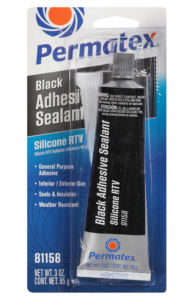
This is a silicone adhesive that is suitable for most types of rubber and in applications requiring water resistance, flexibility, durability, or outdoor projects.
It remains flexible after curing, making it suitable for applications where the rubber will experience movement or vibration after curing. It is waterproof and UV resistant, so it is suitable for outdoor use. It can bond to dissimilar materials like rubber, metal, plastic, and glass.
It does have a longer curing time of 24 hours and is not recommended for heavy-duty structural applications.
Gorilla Clear Grip Contact Adhesive
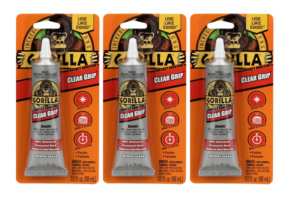
This is a solvent-based contact adhesive that is suitable for flexible bonds that require transparency for aesthetic purposes such as rubber with visible surfaces.
It offers a very transparent clear finish upon curing. Additionally, it is waterproof and resistant to temperature changes making it suitable for outdoor use. The bond is provided is flexible and able to withstand movement or vibration. It also doesn’t require a primer but roughening the surface with sandpaper is recommended for better adhesion.
Devcon 2-Ton Clear Epoxy
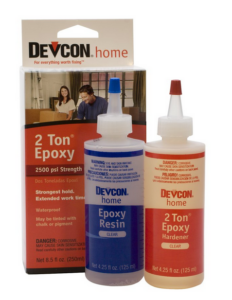
This is a two-part epoxy resin and hardener adhesive that is suitable for heavy-duty bonding and structural applications where strength and durability are of paramount importance. It bonds to a variety of materials including metal, plastic, wood, and rubber. It has a high tensile strength and shear strength once cured and is resistant to chemicals, heat, and water.
It offers a rigid bond so you won’t get the type of flexibility with other adhesives. It works well with silicone and low-energy rubbers. The Devcon Silicone Primer is recommended to increase adhesion.
Conclusion
That concludes our list of the 5 best adhesives for gluing rubber. Use this comparison chart to help you decide further.
| Adhesive | Best For | Primer Needed |
| Loctite Super Glue Gel Control | Quick fixes, small repairs | Loctite SF 770 Primer for silicone/EPDM |
| 3M 847 Nitrile Adhesive | Industrial/automotive use, oil/chemical resistance | None |
| Permatex Black Silicone Sealant | Flexible seals, water-resistant bonds | None |
| Gorilla Clear Grip Adhesive | Aesthetic rubber repairs, transparent bonding | None (surface roughening recommended) |
| Devcon 2-Ton Clear Epoxy | Heavy-duty structural bonding | Devcon Silicone Primer for low-energy rubbers |
If you found this article useful, give us a like or comment below.